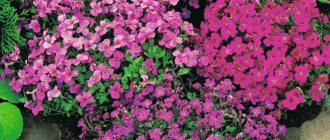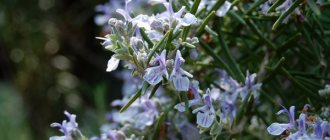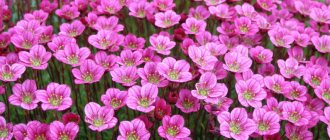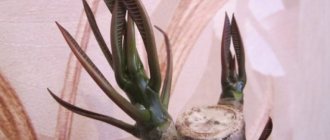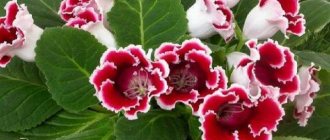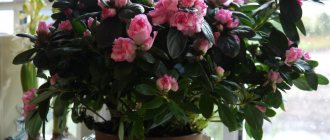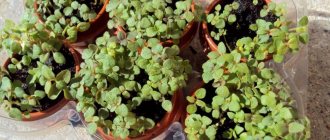Blue-purple shades of bells are often woven into forest forbs. The delicate cups of flowers sway in the wind: you just expect them to ring. Modest flowers create a special aura and fairy tale of the Russian forest. They are affectionately called chebotki, chenilles and bells. From traditional forest flowers, they are gradually selected for flower beds and alpine hills. Growing bluebells gives the garden additional color and modest, understated beauty.
Brief information about the plant
The bell got its name because of its resemblance to a bell. There is a legend that the first church bell was created thanks to a flower. A long time ago, a priest heard the quiet rustling of a bell and decided to recreate its shape.
From time immemorial, the plant has been considered a talisman of goodness, capable of warding off evil spirits.
Based on the height of the stem, bells are divided into:
- Undersized . They can be very tiny - 6 cm, or taller - 20 cm.
- Medium height . Their height does not exceed 1 m.
- Tall . Their stem is higher than 1 m.
Bells can be either annual or perennial. Annual plants reproduce by seeds, biennials by seeds or cuttings, perennials by cuttings or parts of rhizomes. If you use seeds to grow perennial varieties, the plant may not retain the varietal trait. Terry varieties are propagated vegetatively; they do not set seeds.
Description
The length of the flower itself does not exceed 7 cm. Its shape resembles an inverted glass. The edges are curved outward. The color can be very varied. The surface is smooth or terry.
Flowers can be collected in inflorescences or single-growing. The ripe fruit resembles a box. Several slot-like holes are visible on it. As soon as the boxes formed on the bell acquire a brown tint, they are cut off and placed in a ventilated, dry room to ripen. This way you can get high-quality seeds of your favorite plant.
In Latin the flower is called "Campanula", which means bell. In common parlance, the plant is often affectionately called bells, shuttles and chenilles.
Varieties
Low-growing varieties are often planted along the border. They love sunny areas with sandy soil. Low-growing varieties are also called dwarf varieties. The most common ones include:
- Carpathian . It has a stem without leaves, up to 30 cm in height. The plant is perennial, grows in the form of a bush. Blooms for 2 months. Primary colors: blue, purple, white. Loves loose, moist soil. The disadvantages include slow growth. Under favorable conditions it blooms in the third year.
- Birch-leaved . Its leaves resemble birch foliage. The stem is not high, up to 15 cm. The leaves are glossy, the flowers are white. It blooms for more than two months. The plant is perennial and requires protection from the cold in winter. Birch leaf bells are often used to decorate borders, flower beds, and alleys.
Higher grades include:
- Pale ocher . The stem reaches a height of 70 cm. It blooms all summer. The inflorescence resembles a spikelet in appearance. It should be planted on slightly alkaline soils. It is better to choose well-lit areas.
- Perforated . Up to 30 cm in height. The inflorescences are loose, the shape of the flower resembles a star. Blooms blue all summer.
- Spot . The stem is 50 cm high. The leaves are large, egg-shaped. There are up to 5 large flowers on one stem. In winter it requires shelter.
- Milky-flowered . This is the largest representative of the species. Instances reach a height of 80 cm, and an adult plant can grow up to 2 m. The flowers are small, white, about 3 cm, collected in inflorescences. The plant blooms all summer.
Tall types of bellflower
Campanula latifolia
Campanula latifolia
Distributed in Siberia, Southern and Central Europe, Asia Minor, the Caucasus, and the European parts of Ukraine and Russia. Prefers broad-leaved, dark-coniferous, mixed forests and river banks. The stem is straight, bare, up to 1 meter in height. The leaves are double-serrate, 12 cm long and 6 cm wide. The flowers are large, axillary, collected in a narrow, sparsely flowered spike-shaped raceme. The flowers are funnel-shaped, up to 6 cm long, colored blue, white, light blue, the flower blades are slightly bent. They bloom all summer.
Varieties:
- Alba - has white flowers;
- Bruntwood – purple flowers; variety with purple flowers;
- Macrantha - flowers are large, large purple in color.
Campanula persicifolia
Campanula persicifolia photo
Distributed in Western Siberia, Western Europe, the European part of Russia, Ukraine and the Caucasus. Height from 50 cm to 1 meter. The stem is erect, covered with leaves. The leaves are similar to peach foliage: smooth, serrated at the edges. The flowers are large, broadly bell-shaped, up to 5 cm in length, collected in several pieces in a paniculate inflorescence, and have a blue or lilac-blue color. There are terry and crown forms. Blooms from mid-June to mid-July.
Popular varieties:
- Bernice – blue, double flowers;
- Tetam Beauty - large flowers of a light blue hue;
- Exmouth - dusty blue double flowers;
- Snowdrift - white bells.
- New Giant Hybrids - grows up to 75 cm in height, the flowers are large, white and all shades of blue.
Preparing for sowing
To get good and strong seedlings, you should follow certain rules.
When to sow seeds
In order for the plant to bloom in the same year, it is grown by seedlings from seeds in early spring. The best time to plant seeds depending on the region:
- South of Russia - early March;
- Central Russia - mid-March;
- Ural, Siberia - early April.
Seed preparation
Bell seeds are very small and do not require pre-treatment. To increase germination before sowing, they can be treated with a growth stimulator (Epin, Zircon). When using them, you should strictly adhere to the instructions (it is indicated on the packaging), and also monitor the dosage.
What soil to use
Plant the seeds in universal soil for flower seedlings. To improve its structure, you should add sand, perlite, and vermiculite. Ratio 3:1:1:1.
You can also prepare the soil yourself. It includes:
- humus;
- turf land;
- coarse sand.
The proportion is 3:6:1.
What capacity is needed
It is better to use a low, wide container for seedlings. Its depth should not exceed 7 cm. It is worth making drainage holes at the bottom of the container through which excess moisture will escape. It is recommended to disinfect the container before use. To do this, it is treated with a solution of potassium permanganate.
For sowing, it is convenient to use peat cassettes for seedlings - the plant is planted in open ground along with a cup. As it decomposes, it becomes fertilizer.
Propagation by cuttings
These flowers can be propagated using cuttings. In the second year after planting, in the spring, when the stem has formed, the healthiest shoot is selected and a cutting is made. It must have at least three internodes. The leaves are removed from it so that they do not take away the strength of the plant.
The cuttings are planted in well-moistened soil. Two internodes should remain on the surface. Cover the cutting with a cut plastic bottle or glass jar.
We hope that now an elegant “cup and saucer” bell will definitely appear on your site. Growing this plant from seeds, as you can see, is not too difficult. By following all the rules of planting and care, you will be able to admire the luxurious blooms all summer long.
Sowing work
The process of sowing seeds is not complicated; you should follow the instructions:
- A drainage layer 1 cm thick is placed at the bottom of the container. Perlite or expanded clay can be used as drainage.
- Fill the container with soil. You should not fill it to the brim; it is better to leave 1-2 cm free to the top.
- The soil is moistened with warm, settled water.
- Then surface landing is carried out. The seeds are sown on the ground and lightly pressed down.
- Spray the soil using a spray bottle.
- Cover the top with a transparent lid or cling film. This creates a greenhouse effect.
The optimal air temperature in the room with containers is +20-22°C.
The seeds should be kept under the film until the first shoots. In order for the plant to receive enough oxygen and light, it is necessary to remove the covering material for 30 minutes once a day.
Features of the variety: choosing a place for planting
The description of the bell given by experienced gardeners suggests that this plant loves light and moisture. It tolerates temporary drops in temperature well.
Prefers well-fertilized and light soil. Does not tolerate acidic soils and stagnant moisture. In damp areas, the plant simply withers away. For one square meter of clay soil, fifteen kilograms of humus or compost must be added for digging. For loamy soils this amount increases to nineteen kilograms.
How to care for seedlings
Caring for seedlings is an extremely important stage. If certain rules are not followed, the seedlings may die.
Temperature, lighting and watering
After the seedlings emerge, the containers are placed on a sunny windowsill; the air temperature in the room should be +18-22°C. Recommended daylight hours are 12-14 hours. If there is not enough natural light, it is necessary to supplement the seedlings with phytolamps.
Water the seedlings from a syringe or syringe, pouring water in a thin stream under the root. In this case, you need to make sure that it does not get on the leaves. The soil should always be slightly moist.
How and when to pick seedlings
The plant is picked after the appearance of 2-3 true leaves. For this, use individual containers; a volume of 200 ml will be sufficient. Before transplanting, it is necessary to make drainage holes in them. You can use the same soil that was used for sowing the seeds.
Before picking, water the seedlings and leave for 1 hour. The soil will become softer and the seedlings will be easier to remove.
A drainage layer 1-2 cm thick is placed in new containers, filled with soil and small depressions are made. Carefully move the plant along with the lump of earth. It is better to remove seedlings using a spoon or fork. The bell has long roots that are easily damaged.
After transplanting the seedlings into a new container, the soil is compacted. Water with settled water at room temperature. To protect the plant from unnecessary stress, the seedlings are kept in shaded areas for the first 2-3 days after diving.
Top dressing
The first feeding is carried out 2 weeks after picking. Use complex mineral fertilizer for flowering plants, for example, Agricola. Repeated application of fertilizers is repeated after 10-14 days.
Hardening of seedlings
2 weeks before planting seedlings in open ground, a hardening procedure should be carried out. To do this, open a window in the room for 30 minutes. Every day the time is increased by 1 hour. 1 week before planting, the containers are taken outside for 2 hours, also increasing the time spent on the street every day.
When to sow bellflower seeds for seedlings, in what month
When is the best time to plant bellflower seedlings in 2022? Since seedlings grow relatively slowly, it is optimal to sow in March and early April . In the South, planting can be done in early March, in the middle zone (Moscow region) - in mid-March, in Siberia, the Urals, Leningrad region it is better to plant in early April.
You can select the planting dates according to the 2020 Lunar calendar:
- Favorable days for annual crops: in January - 27, 28, 29;
- in February -1-8, 10-20, 25-29;
- in March - 2-8, 10-14, 29-31;
- in April - 1, 2, 5-7, 9, 18-20, 24, 25;
- in February -1-8, 10-20, 25-29;
- in January - 10, 25, 26;
Planting in open ground
Bells are planted in open ground in warm regions in early May, and in cold regions in early June. Bells love open areas; for planting seedlings, you should choose the sunny side.
Only a few bellflower species do well in the shade. They differ from light-loving varieties in the dark color of their foliage.
Most species prefer neutral or slightly alkaline soil. If the soil is heavy enough, then humus or sand is added to it. Poor soil is enriched with turf soil and various fertilizers. Do not add peat or fresh manure to the soil. They can lead to fungal diseases.
The place for the bells should be away from trees and bushes. Large plants with their roots will take the moisture and nutrients they need from the flowers.
Dwarf species are planted at a distance of 10-15 cm from each other. If the bells are medium-sized, then the distance between them should be about 25 cm. Tall ones are planted at intervals of 50 cm. After planting, the soil is pressed down with your hands and watered with water.
Outdoor care
The bell does not need special care. It only needs to be watered in hot months, remove weeds, and loosen the soil. Tall plants should be tied up. Feed flowers in early spring. Nitrogen fertilizer should be scattered over the melted snow. Fertilizer can be applied a second time when the buds begin to form. Timely removal of wilted flowers will help prolong flowering.
Perennial plants require preparation for frost. To do this, at the beginning of October, all stems are cut off at the root. Cover with dry leaves or spruce branches on top. Tall bells are covered with peat or humus. The height of the shelter must be at least 15 cm.
Diseases and pests
Diseases and pests rarely affect bells. Mostly perennial species that grow in the same place for a long time are affected.
- Harmful bacteria accumulate in the soil over many years. They can lead to the death of the flower. To protect the plant, the soil is treated with a 0.2% solution of Fundazol.
- During prolonged rainy weather, a drooling captive may form on the bells. Get rid of it with garlic infusion.
- Of the pests, bellflowers can be affected by slugs. You can drive them out of the area with a decoction of hot pepper. Superphosphate scattered between the flowers also helps a lot.
If you follow all the rules for growing bellflower seedlings from sowing seeds to planting in open ground, then the plant will delight you with its bright flowering for many years.
